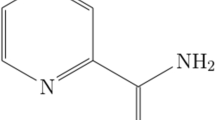Abstract
A simple form of two equations that describe the spinodal line on theT-P plane and the critical point of a multicomponent mixture is suggested. This form is easy to implement numerically. An effective solution algorithm for model equations that is based on the parameter continuation method is proposed. Results of computation are compared with the literature data obtained from other models, as well as with experiments. An example of parameter calculation for benzene hydrogénation in supercritical CO2 is given.
Similar content being viewed by others
Abbreviations
- am, bm:
-
coefficients in equation of state (5a) for component mixture
- Cij, kij :
-
empirical coefficients describing binary interaction between components (i = 1, 2, ...,N;j = 1, 2,..., N;i⊋j)
- f i :
-
fugacity of the ith component, atm
- G:
-
Gibbs free energy, J
- n-N:
-
dimensional vector of the molar numbers of mixture components, mol
- N :
-
the number of mixture components
- P :
-
pressure, atm
- P CI :
-
critical pressure of the ith component, atm
- R :
-
gas constant, 1 atm/(mol K)
- s :
-
formal parameter (arc length)
- S:
-
entropy, J/K
- T :
-
temperature, K
- T Ci :
-
critical temperature of the ith component, K
- V :
-
mixture volume, 1
- V m :
-
molar volume of the mixture, 1/mol
- x-N:
-
dimensional vector of component concentrations
- x :
-
component concentration, mol. fraction
- υ i :
-
chemical potential of the ith component, J/mol
- Ωi :
-
molecule acentricity factor of the ith component
References
Krichevskii, I.R.,Fazovye ravnovesiya v rastvorakh pri vysokikh davleniyakh (Phase Equilibria in Solutions under High Pressures), Moscow: Goskhimizdat, 1952.
Termodinamika ravnovesiya zhidkost’-par (Thermodynamics of Liquid-Vapor Equilibrium), Morachevskii, A.G., Ed., Leningrad: Khimiya, 1989.
Peng, D.Y. and Robinson, D.B., A Rigorous Method for Predicting the Critical Properties of Multicomponent System from an Equation of State,AIChE J., 1977, vol. 23, no. 2, p. 137.
Michelsen, M.L., The Isothermal Flash Problem. Part II: Phase Split Calculation,Fluid Phase Equil., 1982, vol. 9, p. 21.
Heidemann, R.A. and Khalil, A.M., The Calculation of Critical Points,AIChE J., 1980, vol. 26, no. 5, p. 769.
Reid, R.C., Prausnitz, J.M., and Sherwood, T.K.,The Properties of Gases and Liquids, New York: McGraw Hill, 1977. Translated under the titleSvoistva gazov i zhidkostei, Leningrad: Khimiya, 1982.
Soave, G., Equilibrium Constants from a Modified R.K. Equation of State,Chem. Eng. Sci, 1972, vol. 27, no. 6, p. 1197.
Anikeev, V.I. and Ermakova, A., Binary-Interaction Coefficients for the Redlich-Kwong-Soave Equation of State,Teor. Osn. Khim. TekhnoL, 1998, vol. 32, no. 5, p. 508.
Choi, S.H., Harney, D.A., and Book, N.L., A Robust Path Tracking Algorithm for Homotopy Continuation,Comp. Chem. Eng., 1996, vol. 20, no. 6/7, p. 647.
Allgower, E. and Georg, K., Simplical and Continuation Methods for Approximating Fixed Points and Solutions to Systems of Equations,SIAM Rev., 1980, vol. 22, no. 1, p. 28.
Fidkowski, Z.T., Malone, M.F., and Doherty, M.F., Computing Azeotropes in Multicomponent Mixtures,Comp. Chem. Eng., 1993, vol. 17, no. 12, p. 1141.
Bertucco, A., Canni, P., and Devetta, L., Catalytic Hydrogenation in Supercritical CO2: Kinetic Measurements in a Gradientless Internal-Recycle Reactor,Ind. Eng. Chem. Res., 1997, vol. 36, no. 7, p. 2626.
Savage, E.P., Gopalan, S., Mizan, T.I.,et al., Reactions at Supercritical Conditions: Applications and Fundamentals,AlChE J., 1995, vol. 41, no. 7, p. 1723.
Xiang, T., Johnston, K., Woffort, W., and Gloyna, E., Spectroscopic Measurement of pH in Aqueous Sulfuric Acid and Ammonia from Subto Supercritical Conditions,Ind. Eng. Chem. Res., 1996, vol. 35, no. 12, p. 4788.
Debenedetti, P.G. and Reid, R.C., Diffusion and Mass Transfer in Supercritical Fluids,AIChE J., 1986, vol. 32, no. 12, p. 2034.
Uematsu, M. and Frank, E.U., Static Constant of Water and Steam,J. Phys. Chem. Ref. Data, 1980, vol. 9, no. 4, p. 1291.
Author information
Authors and Affiliations
Rights and permissions
About this article
Cite this article
Ermakova, A., Anikeev, V.I. Calculation of spinodal line and critical point of a mixture. Theor Found Chem Eng 34, 51–58 (2000). https://doi.org/10.1007/BF02757464
Received:
Issue Date:
DOI: https://doi.org/10.1007/BF02757464




